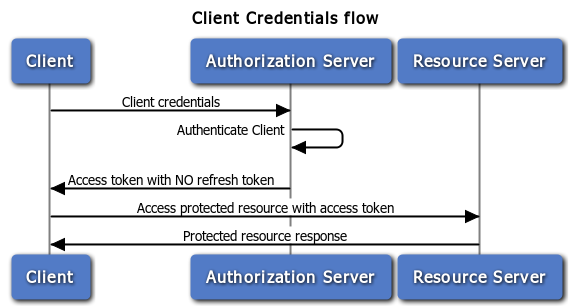Client Credentials Grant是指直接由Client向Authorization Server请求access token,无需用户(Resource Owner)的授权。比如我们提供OpenAPI让大家可以获取园子首页最新随笔,只需验证一下Client是否有权限调用该API,不需要用户的授权。而如果Client需要进行发布博客的操作,就需要用户的授权,这时就要采用Authorization Code Grant。
DotNetOpenAuth是当前做得做好的基于.NET的OAuth开源实现,项目网址:https://github.com/DotNetOpenAuth。
Client Credentials Grant的流程图如下(图片1来源,图片2来源):


一、Client向Authorization Server请求access token
主要操作如下:
1. 由client_id和client_secret构建出credentials。
2. 将credentials以http basic authentication的方式发送给Authorization Server。
3. 从Authorization Server的响应中提取access token
Client的实现代码如下:
public async Task<ActionResult> SiteHome() { var client_id = "m.cnblogs.com"; var client_secret = "20140213"; var credentials = Convert.ToBase64String(Encoding.ASCII.GetBytes(client_id + ":" + client_secret)); var httpClient = new HttpClient(); httpClient.DefaultRequestHeaders.Authorization = new AuthenticationHeaderValue("Basic", credentials); var httpContent = new FormUrlEncodedContent(new Dictionary<string, string> { {"grant_type", "client_credentials"} }); var response = await httpClient.PostAsync("https://authserver.open.cnblogs.com/oauth/token", httpContent); var responseContent = await response.Content.ReadAsStringAsync(); if (response.StatusCode == System.Net.HttpStatusCode.OK) { var accessToken = JObject.Parse(responseContent)["access_token"].ToString(); return Content("AccessToken: " + accessToken); } else { return Content(responseContent); } }
二、Authorization Server验证Client,发放access token
主要操作如下:
1. Authorization Server通过IAuthorizationServerHost.GetClient()获取当前Client。
2. Authorization Server通过IClientDescription.IsValidClientSecret()验证当前Client。
3. 验证通过后,将access token包含在响应中发送给Client。
主要实现代码如下(基于ASP.NET MVC):
1. Authorization Server中Client实体类的实现代码(关键代码是IsValidClientSecret()的实现):
public class Client : IClientDescription { public string Id { get; set; } public string Secret { get; set; } public Uri DefaultCallback { get { throw new NotImplementedException(); } } private ClientType _clientType; public ClientType ClientType { get { return _clientType; } set { _clientType = value; } } public bool HasNonEmptySecret { get { throw new NotImplementedException(); } } public bool IsCallbackAllowed(Uri callback) { throw new NotImplementedException(); } public bool IsValidClientSecret(string secret) { return this.Secret == secret; } }
AuthorizationServerHost的代码(关键代码是GetClient()与CreateAccessToken()的实现):
public class AuthorizationServerHost : IAuthorizationServerHost { public static readonly ICryptoKeyStore HardCodedCryptoKeyStore = new HardCodedKeyCryptoKeyStore("..."); public IClientDescription GetClient(string clientIdentifier) { return ServiceLocator.GetService<IClientService>().GetClient(clientIdentifier); } public AccessTokenResult CreateAccessToken(IAccessTokenRequest accessTokenRequestMessage) { var accessToken = new AuthorizationServerAccessToken { Lifetime = TimeSpan.FromHours(10), SymmetricKeyStore = this.CryptoKeyStore, }; var result = new AccessTokenResult(accessToken); return result; } public AutomatedAuthorizationCheckResponse CheckAuthorizeClientCredentialsGrant(IAccessTokenRequest accessRequest) { //... } public AutomatedUserAuthorizationCheckResponse CheckAuthorizeResourceOwnerCredentialGrant (string userName, string password, IAccessTokenRequest accessRequest) { //... } public DotNetOpenAuth.Messaging.Bindings.ICryptoKeyStore CryptoKeyStore { get { return HardCodedCryptoKeyStore; } } public bool IsAuthorizationValid(IAuthorizationDescription authorization) { return true; } public INonceStore NonceStore { get { return null; } } }
三、Client通过access token调用Resource Server上的API
主要实现代码如下:
public async Task<ActionResult> HomePosts(string blogApp) { //获取access token的代码见第1部分 //... var accessToken = JObject.Parse(responseContent)["access_token"].ToString(); httpClient.DefaultRequestHeaders.Authorization = new AuthenticationHeaderValue("Bearer", accessToken); response = await httpClient.GetAsync("https://api.open.cnblogs.com/blog/posts/sitehome"); return Content(await response.Content.ReadAsStringAsync()); }
四、Resource Server验证Client的access token,响应Client的API调用请求
主要实现代码如下(基于ASP.NET Web API):
1. 通过MessageHandler统一验证access token
public static class WebApiConfig { public static void Register(HttpConfiguration config) { config.MessageHandlers.Add(new BearerTokenHandler()); } }
2. BearerTokenHandler的实现代码(来自DotNetOpenAuth的示例代码):
public class BearerTokenHandler : DelegatingHandler { protected override async System.Threading.Tasks.Task<HttpResponseMessage> SendAsync( HttpRequestMessage request, System.Threading.CancellationToken cancellationToken) { if (request.Headers.Authorization != null && request.Headers.Authorization.Scheme == "Bearer") { var resourceServer = new DotNetOpenAuth.OAuth2.ResourceServer (new StandardAccessTokenAnalyzer (AuthorizationServerHost.HardCodedCryptoKeyStore)); var principal = await resourceServer.GetPrincipalAsync(request, cancellationToken); HttpContext.Current.User = principal; Thread.CurrentPrincipal = principal; } return await base.SendAsync(request, cancellationToken); } }
3. Web API的示例实现代码:
public class PostsController : ApiController { [Route("blog/posts/sitehome")] public async Task<IEnumerable<string>> GetSiteHome() { return new string[] { User.Identity.Name }; } }
四、Client得到Resouce Server的响应结果
根据上面的Resouce Server中Web API的示例实现代码,得到的结果是:
["client:m.cnblogs.com"]
小结
看起来比较简单,但实际摸索的过程是曲折的。分享出来,也许可以让初次使用DotNetOpenAuth的朋友少走一些弯路。
【参考资料】
The OAuth 2.0 Authorization Framework
Claim-based-security for ASP.NET Web APIs using DotNetOpenAuth